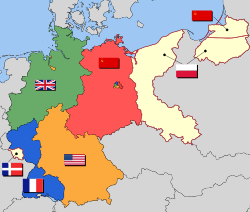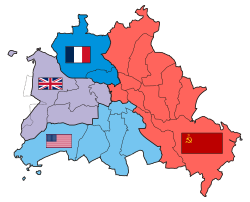Soviet occupation zone of Germany
The Soviet Occupation Zone (German: Sowjetische Besatzungszone (SBZ) or Ostzone Russian: Советская зона Германии, Sovetskaya zona Germanii, "Soviet Zone of Germany") was the area of eastern Germany occupied by the Soviet Union from 1945 on, at the end of World War II. It became East Germany.
Allied-Administered Germany Soviet Occupation Zones of Germany | |||||||||||
|---|---|---|---|---|---|---|---|---|---|---|---|
| 1945 — 1949 | |||||||||||
 Occupation zones in Germany (1945) | |||||||||||
| Status | Military occupation | ||||||||||
| Capital | Berlin (de jure) | ||||||||||
| Governors (1945) | |||||||||||
• Soviet zone | Marshal Zhukov | ||||||||||
• 1953-55 | Georgy Maksimovich Pushkin | ||||||||||
| Historical era | Cold War | ||||||||||
| May 8, 1945 | |||||||||||
| July 5, 1945 1945 | |||||||||||
| 23 May, 1949 | |||||||||||
| 7 October, 1949 1949 | |||||||||||
| September 12, 1990 | |||||||||||
| ISO 3166 code | DE | ||||||||||
| |||||||||||
¹ German reunification took place on October 3, 1990.  | |||||||||||
American forces first occupied some of the area. The Americans withdrew in July 1945 to the agreed occupation zone boundaries.
The Soviet Military Administration in Germany (German initials: SMAD) allowed four political parties to form, but they all had to work in the "All-Party Committee" (the "Nationale Front").
The Social Democratic Party of Germany (SPD) and the Communist Party of Germany were merged into the Socialist Unity Party of Germany (which became the governing party of East Germany). Finally, the SED created other parties, to weaken the Christian Democratic Union and Liberal Democratic Party of Germany.
Originally, Stalin wanted to Sovietize all of Germany, but when the West resisted this idea, he tried to work for a united Germany which would be neutral, but when the West again said no he decided to build a new country out of the Soviet occupation zone. This became East Germany
The Soviet occupation zone included the central parts of Prussia. After Prussia was dissolved by the allied powers in 1947, the area was divided between the German states of Brandenburg, Mecklenburg, Saxony, Saxony-Anhalt und Thuringia.
On October 8, 1949, the part of the Soviet zone west of the Oder-Neisse line became the German Democratic Republic, usually known simply as East Germany. In 1952, the states were dissolved, and changed to 14 districts, plus East Berlin. East Berlin was treated as part of the new East Germany, but technically was part of the Allied-controlled city of Berlin.
